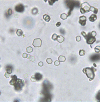Differential identification of urine crystals with morphologic characteristics and solubility test
- PMID: 36164743
- PMCID: PMC9701861
- DOI: 10.1002/jcla.24707
Differential identification of urine crystals with morphologic characteristics and solubility test
Abstract
Background: Urinary crystals are the most diverse forms of urine sediments. Reference images for typical urinary crystals are common, however, but images for interpreting atypical urinary crystals are very rare. The authors reviewed various forms and solubility tests of urine crystals to interpret atypical crystals found in clinical specimens.
Methods: We reviewed textbooks on urinary crystals and articles published in PubMed. Some atypical crystals were confirmed using a solubility test.
Results: The classification, shape, chemical structure, and solubility of the crystals were summarized. In the solubility test, some crystals showed different results; therefore, a new solubility test was proposed based on the literature review. We presented various types of calcium oxalates.
Conclusions: These review articles will be helpful in the examination of atypical crystals found in clinical specimens. The solubility test requires additional studies to discriminate the inconsistent results between the authors.
Keywords: classification; crystal; crystalluria; solubility test; urine.
© 2022 The Authors. Journal of Clinical Laboratory Analysis published by Wiley Periodicals LLC.
Conflict of interest statement
There is no conflict of disclosure.
Figures







References
-
- Cho J, Oh KJ, Jeon BC, Lee SG, Kim JH. Comparison of five automated urine sediment analyzers with manual microscopy for accurate identification of urine sediment. Clin Chem Lab Med. 2019;57:1744‐1753. - PubMed
-
- Kouri T, Fogazzi G, Gant V, Hallander H, Hofmann W, Guder WG. European urinalysis guidelines. Scand J Clin Lab Invest. 2000;231:1‐86. - PubMed
-
- Riley RS, McPherson RA. Basic examination of urine. In: McPherson RA, Pincus MR, eds. Henry's Clinical Diagnosis and Management by Laboratory Methods. 24th ed. Elsevier; 2022:493‐499.
-
- Itoh K, Miyachi H, Asai S, Nozaki T. Atlas of Urinary Sediment. Sysmex Corporation; 2014:85‐98.
-
- Fogazzi GB. Crystalluria: a neglected aspect of urinary sediment analysis. Nephrol Dial Transplant. 1996;11:379‐387. - PubMed
Publication types
MeSH terms
Substances
LinkOut - more resources
Full Text Sources

